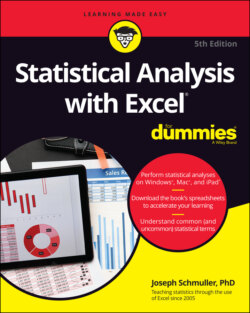Читать книгу Statistical Analysis with Excel For Dummies - Joseph Schmuller - Страница 17
Inferential Statistics: Testing Hypotheses
ОглавлениеIn advance of doing a study, a statistician draws up a tentative explanation — a hypothesis — of why the data might come out a certain way. After the study is complete and the sample data are all tabulated, the statistician faces the essential decision every statistician has to make: whether or not to reject the hypothesis.
That decision is wrapped in a conditional probability question — what’s the probability of obtaining the sample data, given that this hypothesis is correct? Statistical analysis provides tools to calculate the probability. If the probability turns out to be low, the statistician rejects the hypothesis.
Suppose you’re interested in whether or not a particular coin is fair — whether it has an equal chance of coming up heads or tails. To study this issue, you'd take the coin and toss it a number of times — say, 100. These 100 tosses make up your sample data. Starting from the hypothesis that the coin is fair, you'd expect that the data in your sample of 100 tosses would show around 50 heads and 50 tails.
If it turns out to be 99 heads and 1 tail, you’d undoubtedly reject the fair coin hypothesis. Why? The conditional probability of getting 99 heads and 1 tail given a fair coin is very low. Wait a second. The coin could still be fair and you just happened to get a 99-1 split, right? Absolutely. In fact, you never really know. You have to gather the sample data (the results from 100 tosses) and make a decision. Your decision might be right, or it might not.
Juries face this dilemma all the time. They have to decide among competing hypotheses that explain the evidence in a trial. (Think of the evidence as data.) One hypothesis is that the defendant is guilty. The other is that the defendant is not guilty. Jury members have to consider the evidence and, in effect, answer a conditional probability question: What’s the probability of the evidence given that the defendant is not guilty? The answer to this question determines the verdict.
